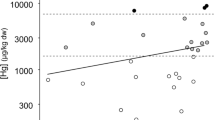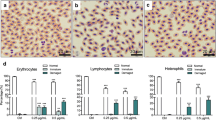Abstract
In Croatia, Podravina is a well-known lead-polluted region due to the intensive exploitation of natural gas, a highly developed agricultural industry, and a traffic hub with several heavily traveled roads. It represents a natural environment with a great variety of wildlife, especially hares (Lepus europaeus Pallas), which may serve as an indicator for environmental quality assessment. This study was conducted to estimate the bioaccumulation of lead in hare liver, kidney, muscle, and brain during long-term exposure and its impact on the oxidative status of the organism and to investigate a possible lead exchange ionic mechanism in the brain. In the organs of two hare groups (experimental from polluted area and control from the island of Krk), Ca, Fe, Mg, Na, lead concentrations, and antioxidant enzyme defense system were analyzed. The accumulation of lead was highest in the brain (3.7-fold higher compared to the control group) and lowest in the liver (1.6-fold higher compared to the control group). Kendall-Tau and multiple regression analysis showed that the increased lead content caused a stronger exchange of Ca and Na ions in the brain. We proposed that lead either mobilizes intracellular cation stores or causes competitive displacement of Ca from the binding site in intoxicated cells. A linear predictive model for cell intoxication by lead was proposed, where GPx and SOD were predominantly influenced by long-term lead exposure. The presented results showed that long-term lead exposure in hares negatively affected their oxidative status and caused the strongest toxicity in the brain and muscles, making their survival and/or population vulnerable.



Similar content being viewed by others
Data Availability
We agree to full transparency of the data if needed. Raw data will be provided on request.
References
Lupino-Gratão P, Vara Prasad NM, Cardoso FP, Lea PJ, Azevedo AR (2005) Phytoremediation: green technology for the clean-up of toxic metals in the environment. Braz J Plant Physiol 17(1):53–64. https://doi.org/10.1590/S1677-04202005000100005
Reimann C, Fabian K, Birke M, Filzmoser P, Demetriades A, Négrel P, Oorts K, Matschullat J, de Caritat P, The GEMAS Project Team (2017) Establishing geochemical background and threshold for 53 chemical elements in European agricultural soil. J Appl Geochem. https://doi.org/10.1016/j.apgeochem.2017.01.021
Peh Z (2009) Statistical processing. In: Halamić J, Miko S (eds) Geochemical Atlas of the Republic of Croatia. Croatian Geological Survey, Zagreb, pp 68–69
Špirić Z, Srebočan E, Prevendar Crnić A (2012) Mercury in hares organs (Lepus europaeus Pallas) in the vicinity of the mercury-contaminated natural gas treatment plant in Croatia. J Environ Sci Health 47(1):77–83. https://doi.org/10.1080/10934529.2012.629584
Wajdzik M, Halecki W, Kalarus K, Gąsiorek M, Pająk M (2017) Relationship between heavy metal accumulation and morphometric parameters in European hare (Lepus europaeus) inhabiting various types of landscapes in southern Poland. Ecotoxicol Environ Saf 145:16–23. https://doi.org/10.1016/j.ecoenv.2017.06.070
Reichlin T, Klansek E, Hackländer K (2006) Diet selection by hares (Lepus europaeus) in arable land and its implications for habitat management. Eur J Wildl Res 52:109–118. https://doi.org/10.1007/s10344-005-0013-3
Sharma P, Dubey RS (2005) Lead toxicity in plants. Braz J Plant Physiol 17(1):35–52. https://doi.org/10.1590/S1677-04202005000100004
Petrović Z, Teodorović V, Dimitrijević M, Borozan S, Beuković M, Milićević D (2013) Environmental Cd and Zn concentrations in liver and kidney of European hare from different Serbian regions: age and tissue differences. Bull Environ Contam Toxicol 90(2):203–207. https://doi.org/10.1007/s00128-012-0901-7
Linšak Ž, Tomić Linšak D, Špirić Z, Srebočan E, Glad M, Milin Č (2013) Effects of mercury on glutathione and glutathione-dependent enzymes in hares (Lepus europaeus Pallas). J Environ Sci Health A 48(11):1325–1332. https://doi.org/10.1080/10934529.2013.781869
Tomić Linšak D, Linšak Ž, Špirić Z, Srebočan E, Glad M, Cenov A, Jakovac H, Milin Č (2014) Influence of cadmium on metallothionein expression and products of lipid peroxidation in the organs of hares (Lepus europaeus Pallas). J Appl Toxicol 34(3):289–295. https://doi.org/10.1002/jat.2880
Kalia K, Flora SJ (2005) Strategies for safe and effective therapeutic measures for chronic arsenic and lead poisoning. J Occup Health 47(1):1–21. https://doi.org/10.1539/joh.47.1
Poreba R, Gac P, Poreba M, Andrzejak R (2011) Environmental and occupational exposure to lead as a potential risk factor for cardiovascular disease. Environ Toxicol Pharmacol 31(2):267–277. https://doi.org/10.1016/j.etap.2010.12.002
Farmand F, Ehdaie A, Roberts CK, Sindhu RK (2005) Lead-induced dysregulation of superoxide dismutase, catalase, glutathione peroxidase, and guanylate cyclase. Environ Res 98(1):33–39. https://doi.org/10.1016/j.envres.2004.05.016
Wang J, Wu J, Zhang Z (2006) Oxidative stress in mouse brain exposed to lead. Ann Occup Hyg 50(4):405–409. https://doi.org/10.1093/annhyg/mei079
Zhang YM, Liu XZ, Lu H, Mei L, Liu ZP (2009) Lipid peroxidation and ultrastructural modifications in brain after perinatal exposure to lead and/or cadmium in rat pups. Biomed Environ Sci 22(5):423–429. https://doi.org/10.1016/S0895-3988(10)60021-9
Prasanthi RPJ, Devi CB, Basha DC, Reddy NS, Reddy GR (2010) Calcium and zinc supplementation protects lead (Pb)-induced perturbations in antioxidant enzymes and lipid peroxidation in develo** mouse brain. Int J Dev Neurosci 28(2):161–167. https://doi.org/10.1016/j.ijdevneu.2009.12.002
Flora G, Gupta D, Tiwari A (2012) Toxicity of lead: a review with recent updates. Interdiscip Toxicol 5(2):47–58. https://doi.org/10.2478/v10102-012-0009-2
Singh PK, Nath R, Pal R, Dixit RK (2019) Environmental lead toxicity. book: Heavy Metals Toxicity in Biological Systems. Publisher, Discovery Publishing House Pvt. Ltd., New Delhi, India, pp 34–50
(2019) Official Gazette of the Republic of Croatia, 140/2005 and 37/2019 Croatian Hunting Law; Ordinance on the manner of use of hunting weapons and ammunition. Croatian Parliament, Croatia 2005, Ministry of Agriculture, Croatia
European Union (2013) Council Directive 92/43/EEC of the European Parliament and the Council of 21 May 1992 on the conservation of natural habitats and of wild fauna and flora. https://eur-lex.europa.eu/legal-content/EN/TXT/PDF/?uri=CELEX:31992L0043&from=EN. Accessed 31 Aug 2021
Bradford MM (1976) A rapid and sensitive method for the quantitation of microgram quantities of protein utilizing the principle of protein-dye binding. Anal Biochem 72(1–2):248–254. https://doi.org/10.1006/abio.1976.9999
Marinić J, Broznić D, Milin Č (2016) Preexposure to olive oil polyphenols extract increases oxidative load and improves liver mass restoration after hepatectomy in mice via stress-sensitive genes. Oxid Med Cell Longev 2016:1–13. https://doi.org/10.1155/2016/9191407
Onyango GI, Shaharyar KM (2006) Oxidative stress, mitochondrial dysfunction, and stress signaling in Alzheimer’s disease. Curr Alzheimer Res 3(4):339–349. https://doi.org/10.2174/156720506778249489
Dringen R, Gutterer JM (2002) Glutathione reductase from bovine brain. Methods Enzymol 348:281–288. https://doi.org/10.1016/s0076-6879(02)48646-6
Sindhu RK, Ehdaie A, Farmand F, Dhaliwal KK, Nguyen T, Zhan CD, Roberts CK, Vaziri ND (2005) Expression of catalase and glutathione peroxidase in renal insufficiency. Biochim Biophys Acta 1743(1–2):86–92. https://doi.org/10.1016/j.bbamcr.2004.08.013
Drozd R, Pilarczyk R, Pilarczyk B, Drozd A, Tomza-Marciniak A, Bombik T, Bąkowska M, Bombik E, Jankowiak D, Wasak A (2015) Activity of selected antioxidant enzymes, selenium content and fatty acid composition in the liver of the brown hare (Lepus europaeus L.) in relation to the season of the year. Biol Trace Elem Res 168(2):421–428. https://doi.org/10.1007/s12011-015-0385-5
Tan AS, Berridge MV (2000) Superoxide produced by activated neutrophils efficiently reduces the tetrazolium salt, WST-1 to produce a soluble formazan: a simple colorimetric assay for measuring respiratory burst activation and for screening anti-inflammatory agents. J Immunol Methods 238(1–2):59–68. https://doi.org/10.1016/s0022-1759(00)00156-3
Dawn-Linsley M, Ekinci FJ, Ortiz D, Rogers E, Shea TB (2005) Monitoring thiobarbituric acid-reactive substances (TBARs) as an assay for oxidative damage in neuronal cultures and central nervous system. J Neurosci Methods 141(2):219–222. https://doi.org/10.1016/j.jneumeth.2004.06.010
Bressler J, Kim KA, Chakraborti T, Goldstein G (1999) Molecular mechanisms of lead neurotoxicity. Neurochem Res 24(4):595–600. https://doi.org/10.1023/a:1022596115897
Dobrakowski M, Boroń M, Birkner E, Kasperczyk A, Chwalińska E, Lisowska G, Kasperczyk S (2017) The effect of a short-term exposure to lead on the levels of essential metal ions, selected proteins related to them, and oxidative stress parameters in humans. Oxid Med Cell Longev. https://doi.org/10.1155/2017/8763793
Pedersen S, Lierhagen S (2006) Heavy metal accumulation in arctic hares (Lepus arcticus) in Nunavut, Canada. Sci Total Environ 368(2–3):951–955. https://doi.org/10.1016/j.scitotenv.2006.05.014
Amuno S, Niyogi S, Amuno M, Attitaq J (2016) Heavy metal bioaccumulation and histopathological alterations in wild Arctic hares (Lepus arcticus) inhabiting a former lead-zinc mine in the Canadian high Arctic: a preliminary study. Sci Total Environ 556:252–263. https://doi.org/10.1016/j.scitotenv.2016.03.007
Massányi P, Tataruch F, Slameka J, Toman R, Jurík R (2003) Accumulation of lead, cadmium, and mercury in liver and kidney of the brown hare (Lepus europaeus) in relation to the season, age, and sex in the West Slovakian lowland. J Environ Sci Health Toxic/Hazard Subst Environ Eng 38(7):1299–1309. https://doi.org/10.1081/ESE-120021127
Kolesarova A, Slamecka J, Jurcik R, Tataruch F, Lukac N, Kovacik J, Capcarova M, Valent M, Massanyi P (2008) Environmental levels of cadmium, lead and mercury in brown hares and their relation to blood metabolic parameters. J Environ Sci Health Toxic/Hazard Subst Environ Eng 43(6):646–650. https://doi.org/10.1080/10934520801893741
Patrick L (2006) Lead toxicity part II: the role of free radical damage and the use of antioxidants in the pathology and treatment of lead toxicity. Altern Med Rev 11(2):114–127
Mates JM (2000) Effects of antioxidant enzymes in the molecular control of reactive oxygen species toxicology. Toxicology 153(1–3):83–104. https://doi.org/10.1016/s0300-483x(00)00306-1
Gurer H, Ercal N (2000) Can antioxidants be beneficial in the treatment of lead poisoning? Free Radic Biol Med 29(10):927–945. https://doi.org/10.1016/s0891-5849(00)00413-5
Sandhir R, Julka D, Gill KD (1994) Lipoperoxidative damage on lead exposure in rat brain and its implications on membrane bound enzymes. Pharmacol Toxicol 74(2):66–71. https://doi.org/10.1111/j.1600-0773.1994.tb01077.x
Limón-Pacheco J, Gonsebatt ME (2009) The role of antioxidants and antioxidant-related enzymes in protective responses to environmentally induced oxidative stress. Mutat Res Genet Toxicol Environ Mutagen 674(1–2):137–147. https://doi.org/10.1016/j.mrgentox.2008.09.015
Obolenskayaa MY, Teplyuka NM, Divi RL, Poirier MC, Filimonovac NB, Zadrozna M, Pasanene MJ (2010) Human placental glutathione S-transferase activity and polycyclic aromatic hydrocarbon DNA adducts as biomarkers for environmental oxidative stress in placentas from pregnant women living in radioactivity- and chemically-polluted regions. Toxicol Lett 196(2):80–86. https://doi.org/10.1016/j.toxlet.2010.03.1115
Gürer H, Ozgünes H, Neal R, Spitz DR, Erçal N (1998) Antioxidant effects of N-acetylcysteine and succimer in red blood cells from lead-exposed rats. Toxicology 128(3):181–189. https://doi.org/10.1016/s0300-483x(98)00074-2
Mohammad IK, Mahdi AA, Raviraja A, Najmul I, Iqbal A, Thuppil V (2008) Oxidative stress in painters exposed to low lead levels. Arh Hig Rada Toksikol 59(3):161–169. https://doi.org/10.2478/10004-1254-59-2008-1883
Funding
This study was supported by a grant from the Croatian Ministry of Science (Project Nos. 053–0532400-2362 and 062–0621341-0061), a grant from the Program of the European Community for Research and Technological Development (Project No. FOODCT-2006–016253), and a grant from the University of Rijeka, Croatia (Grant No. Uniri-biomed-18–155-1304).
Author information
Authors and Affiliations
Contributions
Željko Linšak: Investigation, formal analysis, data curation, and writing—original draft preparation.
Ivana Gobin: Validation and reviewing and editing.
Dijana Tomić Linšak: Conceptualization, methodology, formal analysis, data curation, writing, reviewing and editing, and supervision.
Dalibor Broznić: Formal analysis, data curation, software, visualization, writing, and reviewing and editing.
All authors read and approved the final draft of the manuscript.
Corresponding author
Ethics declarations
Ethics Approval
The animals were hunted during the regular hunting period in Croatia, in compliance with the Law on Hunting taken from the European Union Directive, and donated by the hunters, so no approval of research ethics committees was required to accomplish the goals of this study.
Conflict of Interest
The authors declare no competing interests.
Additional information
Publisher’s Note
Springer Nature remains neutral with regard to jurisdictional claims in published maps and institutional affiliations.
Rights and permissions
About this article
Cite this article
Linšak, Ž., Gobin, I., Linšak, D.T. et al. Effects of Long-Term Lead Exposure on Antioxidant Enzyme Defense System in Organs of Brown Hare (Lepus europaeus Pallas) as a Bioindicator of Environmental Pollution in Croatia. Biol Trace Elem Res 200, 5091–5103 (2022). https://doi.org/10.1007/s12011-021-03090-6
Received:
Accepted:
Published:
Issue Date:
DOI: https://doi.org/10.1007/s12011-021-03090-6




